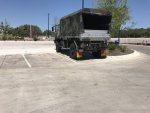justin22885
New member
- 56
- 0
- 0
- Location
- Wisconsin
So here is my situation. I am looking to buy land that does not have road access and build a homestead. This means I will need a vehicle that can both go offroad, and carry a good bit of supplies and equipment. The areas I am considering doing this is eastern WA state, Idaho, or more likely Alaska. This means something that can deal with a lot of snow and cold.
I was looking at the M35s, 5 tons, and LMTVs and the LMTV interests me before for a few reasons. It is a shorter vehicle, but it has the same size bed and carrying capacity as a full size unbobbed deuce. Something else that seems to be true for the LMTV is that the cab is also better sealed up which might be better for cold weather and heating, and the auto transmission is nice.
I would probably be making some modifications and upgrades as I go to better tailor it to my needs. I may look into suspension modifications to improve more regular off-road trail usage. I may look into proving its cold weather capabilities with insulation and heat, and cold-weather starting. And the consensus I am seeing is that people like the Allison transmission but hate the 3116 engine due to reliability issues and availability. Being in the middle of nowhere, reliability and availability of parts will be important so I may get the LMTV with the plan to replace the engine later on down the road, though what I have not yet decided what I would switch it to.
So, is the LMTV the type of vehicle I want? Or do you think I would be better off with one of the 6x6 vehicles available? If so, why?
I was looking at the M35s, 5 tons, and LMTVs and the LMTV interests me before for a few reasons. It is a shorter vehicle, but it has the same size bed and carrying capacity as a full size unbobbed deuce. Something else that seems to be true for the LMTV is that the cab is also better sealed up which might be better for cold weather and heating, and the auto transmission is nice.
I would probably be making some modifications and upgrades as I go to better tailor it to my needs. I may look into suspension modifications to improve more regular off-road trail usage. I may look into proving its cold weather capabilities with insulation and heat, and cold-weather starting. And the consensus I am seeing is that people like the Allison transmission but hate the 3116 engine due to reliability issues and availability. Being in the middle of nowhere, reliability and availability of parts will be important so I may get the LMTV with the plan to replace the engine later on down the road, though what I have not yet decided what I would switch it to.
So, is the LMTV the type of vehicle I want? Or do you think I would be better off with one of the 6x6 vehicles available? If so, why?



